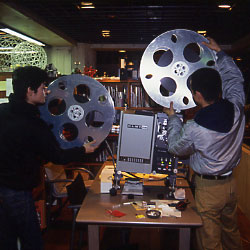When a shaft of light flickering 24 times per second hits the silver screen in the darkness of a spacious basement, the light bursts and scatters to create another dimension of time-space.
In the midst of the video rental age, this workshop was named and organized as an old-fashioned 'cine club' by choice. That was to immerse participants in that mysterious sensation that is only possible with 'film'; a creation of light and sound. A nine-metre Cinemascope-sized screen in the Tochoji Auditorium P3 made our luxurious dream possible.
First Showing
22 January 1992
Cien Ninos Esperando un Tren - One Hundred Children Waiting for a Train Director: Ignacio Agüero 1988 Chile 16mm Colour 57minutes
In a little mountain village in Chile, children who have never seen films before get together at a village church for a 'film school for children' and learn how to make a film. The children experience optical cinema principles and the wonders of cameras and lenses, build zoetropes and thaumatropes, the prototypical instruments of the cinema, and study the history of cinema and its techniques over a period of six months. Then they decide a theme, write a scenario and storyboard, and shoot with a paper camera.
The first cine club showing was to reevaluate what film is and to become a kid again with cinema by appreciating a documentary about children and cinema. Several optical toys using basic visual effects were introduced at the workshop after the viewing. Also video excerpts of films with the theme of 'cinema' were shown.
Second Showing
15 February 1992
Ryakusho Renzoku Shasatsuma - AKA Serial Killer
Director: Masao Adachi, 1969, Japan, 35mm Eastman Colour, 86 minutes
An invisible serial killer frightened Japan at the end of the 1960s with four consecutive shooting in Tokyo, Kyoto, Hakodate and Nagoya that were apparently without a motive. Masao Nagayama, aka ‘serial killer’, was only nineteen at the time of his arrest. The film depicts nineteen years of his life by shooting landscapes that he was supposed to have seen. With the concept of a film made only with landscapes, Cine Club dug out this legendary 'landscape movie' that was rarely shown and buried deep in the history of film. It was the work of Masao Adachi when he was thirty.
The original plan was to show news clips of the serial killer from the 60s together with the film, but permission was not granted. Copies of newspaper articles of the incidents were shown at the viewing.
Third Showing
6, 7, 8 August 1992
Toki ga Midarefuku -Time Blows On
Director: Katsu Kanai, 1991, Japan, 16mm Colour, 64 minutes
During the late 60s and early 70s Katsu Kanai produced Smiling Galaxy, a unique trilogy that consisted of Mujin Retto - Nobody's Archipelago, Good Bye, and Okoku - Kingdom which were well received at a variety of international film festivals, including the Nyon International Documentary Film Festival, Switzerland where he won a grand prize. He produced another trilogy, the so-called cine poem Time Blows On in the 80s which consisted of Yume Hashiru - Dream Run (1987), Ipponshobu no Kirigirisu - One Game Grasshopper, (1988) and Jo no Uta ga Kikoeru - Jo's Song is Heard (1989). These films were shot in a totally different style from his previous work, and the films were supposed to be in three different styles of poetry; Tanka, Haiku and freestyle.
Kanai's films are alive and poetic and most suitable for P3 Cine Club, which tried to find film in films. Katsu Kanai was invited to the showing and gave a talk and answered questions about his private and cosmic films in an intimate setting.

